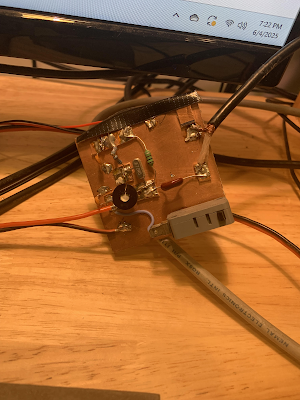Podcasting since 2005! Listen to Latest SolderSmoke
Tuesday, June 17, 2025
Sunday, June 15, 2025
A Nice Quick HW-101 Restoration Video
This video is almost enough to get me to work on my old HW-101.
Pete N6QW has been working on an HW-32A monobander. Some of the info in this video might be applicable.
Saturday, June 14, 2025
Car Talk
Dewey, Cheatham & Howe! Right in the window!
How computers in cars have killed the joy. "There is just not a lot to be in love with anymore."
"The show sounds like the kind of thing you'd hear on a high school PA system." Indeed.
Other influences: Jean Shepherd. HCJB. Radio Moscow. More to follow.
Here is their 1999 MIT Commencement Speech: https://www.youtube.com/watch?v=KWG1Yxoa_Os
Friday, June 13, 2025
Britain's Secret Listeners
Today Hack-A-Day has an unsually good report on Britain's Voluntary Interceptors. I was especially touched by the story of the guy who provided reports while still bedridden from devastating wounds received in World War I.
https://hackaday.com/2025/06/12/crowdsourcing-sigint-ham-radio-at-war/#more-786810
I've had the video on the SolderSmoke blog several times. It is so good that it warrants inclusion yet again:
https://www.youtube.com/watch?v=RwbzV2Jx5Qo&t=228s
That regen looks a lot like the one I bought at the Kempton Park rally (London) so long ago. I still have it. And those headphones found in the old "radar" station look a lot like some that I have in my shack today. And of course there is that HRO dial. I build a whole receiver around that gem from Armand WA1UQO.
I thought the comments on the ability to detect the nationality of the enemy operator from his Morse Code "fist" (sending style) was very interesting.
Three cheers for the Voluntary Interceptors!
Monday, June 9, 2025
Rick W1DSP's FB SolderSmoke Direct Conversion Receiver -- Exploring the Rabbit Holes
Sunday, June 8, 2025
Phil W1PJE, Director of MIT's Haystack Observatory, visits SolderSmoke East, Talks Radio with N2CQR and KK4DAS
Saturday, June 7, 2025
A FIRST! K1OA Contact with N2CQR -- All Homebrew with SolderSmoke Direct Conversion Receivers on Both Ends
At around 0630 EDT on June 7, 2025 I heard K1OA calling CQ on 7030 kHz CW. This was exactly where I had a crystal. I called him, but he didn't hear me. I sent him an e-mail. We tried again -- he heard me calling him and I heard him responding by calling me, but I don't think we succeeded in exchanging signal reports. It was close, but no cigar.
I had to walk the dog. Scott and I agreed to meet on 7030 kHz at 0730 EDT. Arggh. There was a QSO there. I thought we might have to try to change frequency, but this would have been tough because both of us were crystal controlled on transmit. Fortunately, the contact on 7030 kHz wrapped up. Scott called me, I responded, and we were able to exchange signal reports. I was so excited that I almost forgot to hit the record button on my phone. But I caught the last minute or so. See above.
This was really something. This really goes to prove what Dean and I have been saying all along: this receiver is not a toy! It can be used for real ham radio contacts. And now we have had these receivers on both ends of a contact. For transmit, Scott was using a KA4KXX transmitter with about 3 watts output. I was on my Tuna Tin 2 at about half a watt output.
Thanks Scott! And thank you Walter!
Friday, June 6, 2025
A Tale of "Ten Minute Transmitters" and "Tuna Tin Twos": N2CQR Goes Back to CW QRP!
Inspired by K1OA and KA4KXX, I put the SolderSmoke DC receiver to work on the CW portion of 40 meters. At first I used a very (perhaps overly) simple "Ten Minute" transmitter. On June 4, 2025 I worked N2WJW in New Jersey. But the transmitter drifted as it got hot. So I switched to the more robust Tuna Tin 2 (TWO transistors!) and worked W2XS in NY and N9FGC in Indiana on June 5. With both transmitters I was "rock bound" -- crystal controlled. Power out was always less than 200 milliwatts. Antenna was a low to the ground dipole. The receiver was powered by our beloved 9V battery. The transmitter had a second 9V battery. Some observations: First, even if you CAN hear other signals, the different tones allow your brain to seperate them out (this has long been known to CW operators, but might not be readily apparent to newcomers). So even if the DC receiver is broad in frequency response and even though it IS also receiving the other side of zero beat, you can make CW contacts (unless, of course, another station is on a frequency that produces exactly the same tone as the one you are trying to work), even at very low power . Second, you don't always really have to be right on the other station's frequency. Here's why: If he is looking he can see you in his waterfall! So that SDR waterfall is now a friend to crystal-controlled HDR operators. Who would have thought? Above is a picture of the my station with the Ten Minute transmitter. See the notes I wrote on the QSO with N2WJW.
Sunday, June 1, 2025
Alan Wolke W2AEW's Build of the SolderSmoke Direct Conversion Receiver
Ashish N6ASD's Beautiful SolderSmoke Direct Conversion Receiver -- Built in Bangalore -- "This was such a fun project. This was my first direct conversion build, and I learned a lot along the way."
Saturday, May 31, 2025
Not a Toy! K1OA Making Contacts with the SolderSmoke Direct Conversion Receiver and a KA4KXX Transmitter
This goes to prove what we have been saying all along: this receiver is not a toy! It is capable of operating as part of a real 2-way ham radio station. Hall of Fame member Scott K1OA has paired his receiver up with a Merry Christmas transmitter designed by Walter KA4KXX and has been making CW contacts with it (see above). Walter supplied the crystal and many of the needed parts. Scott has already worked WA9RNE, N4HAY and W3RJ, and has tried making contact with Walter but no luck yet. He has gotten RBN reports from Germany and New Zealand. All that with just 3 watts.
This is not the first time this receiver has been out to use. I made one contact with it using a "Ten Minute" QRPp transmitter that I had intended only to use for test purposes:
https://soldersmoke.blogspot.com/2023/02/first-qso-with-high-school-receiver-100.html
HoF member Aaron ZL1AUN used his receiver with an SSB transmitter to make contact using his receiver:
https://soldersmoke.blogspot.com/2025/02/soldersmoke-direct-conversion-receiver_23.html We understand Aaron's article about the receiver has been published in "Break-In" magazine -- we hope to get a copy (electronic would be fine!)
And who can forget HoF member Nate KA1MUQ who turned his "frying pan" direct conversion receiver into a double sideband transceiver and used it to make phone contact with Idaho from California:
https://soldersmoke.blogspot.com/2025/03/nate-ka1muq-turns-his-frying-pan-dc.html
If anyone is aware of other contacts made using this receiver, please let me know.
Friday, May 30, 2025
Hiss, Filters, QRM, and Hearing Loss: Do we need AF filters in direct conversion receivers?
Messages on Discord about the need to knock down higher frequency audio response in the SolderSmoke direct conversion receiver got me thinking.
I agree with Rick Campbell and others on the benefits of hearing a "wide open" direct conversion receiver. But Rick and others have built DC receivers with 3 kHz low pass AF filters. This made me ask myself a question: Is an audio filter in a direct conversion receiver a good idea?
And I started wondering if perhaps I was being too dismissive about the complaints about high frequency audio -- I had been attributing them to newcomers who were just unaccostomed to radio noise or "static." But maybe there was more to it than that. Maybe a big part of the problem was in my head, specifically in my ears. So this morning I did an experiment. I took an online hearing test. First, without my hearing aids: As expected, it showed significant high frequency loss. (It was as if the US Army had installed a 3 kHz audio low pass filter in my head!) Then I put my hearing aids in and retook the test: This time I passed the test and showed no loss. I then listened to the DC receiver with my hearing aids in. Now I could hear what builders on the Discord server were commenting on: I could hear higher frequency hiss, and, more importantly, stations that were producing 4-5 kHz sounds on my speaker were audible and annoying.
So I went back to Wes Hayward's November 1968 QST article. In his receiver, he has a low pass AF filter using an 88 MILLIHenry coil and a couple of capacitors to ground. I had a few of the coils (given to me years ago by a NOVA QRP club member) so I built it. With my hearing aids in, I noticed an immediate improvement. I then did what one of the Discord builders did and put the filter in with a switch that would let me make "with and without" comparisons. The filter definitely cuts down on any AF above about 3.5 kHz. And it doesn't seem to do damage to the desired signal. This is useful. I left the W7EL diplexer in the circuit.
This filter won't solve the image or "opposite sideband" problem inherent to simple DC receivers, but it will help with signals or noise that are producing tones above about 3.5 kHz in the receiver. I think this is especially important in countries in which there is a lot of SSB crowding on 40 meters. The UK, for example, has an allocation from 7.0 to 7.2 MHz. In the US we go from 7.0 to 7.3 MHz. That is a big difference.
So the answer is probably yes, an AF filter in a direct conversion receiver is probably a good idea, especially if you can switch the filter out of the receiver. You can live without these filters. Not having the filter keeps the receiver very simple, and lets it sound really great. But having the filter in there does help reduce interference and high frequency hiss. So I think this is a useful add-on mod for builders who see a need to cut down on the kind of interference that a lack of this filter causes.
In 2019 W7ZOI noted: "Another unusual element is the 88 mH toroid used in the audio low pass filter at the detector output. A viable substitute would be a 100 mH inductor with radial leads. The muRata 19R107C (from Mouser) should work. Bourns also offers a variety of similar parts."









































